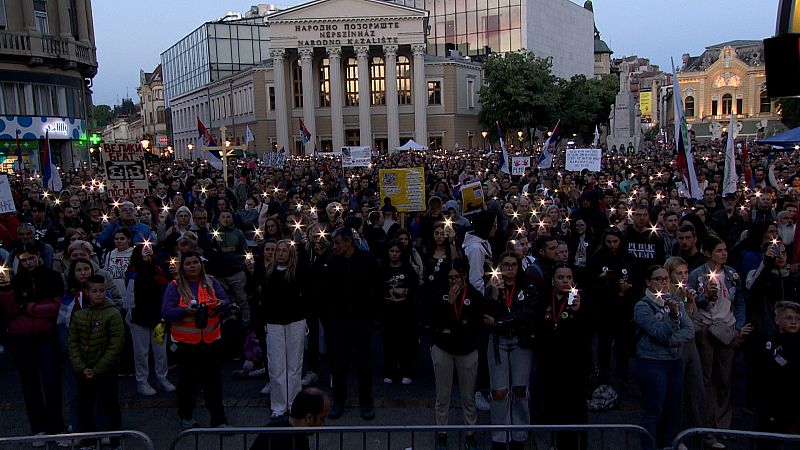Serbian Protesters Flood Subotica, Demanding Justice for Novi Sad Victims

On Saturday in Subotica, motorcyclists, farming tractors operators, and war veterans offered protection during a student-organised protest that lasted throughout the day.
In the north Serbian city home to over 90,000 residents, including a considerable Hungarian population, numerous universities have seen their students protesting since November. This followed a tragic incident where an awning collapsed at the Novi Sad train station, resulting in 16 fatalities.
They continue to think that those who are accountable have not yet faced full justice.
Many protesters were anticipated to come into the city from nearby rural villages as well as from the regional capital, Novi Sad. Some participants made their way by bike or on foot.
Since protesters had earlier faced assaults from vandals, whom some suspected of being supporters of the ruling SNS party, the gathering in Subotica commenced with stringent security measures in place.
The police redirected traffic away from majority of the routes entering the downtown area, whereas access points utilized by demonstrators within the city core were entirely obstructed by tractors driven by farmers supporting the protest movement. Meanwhile, ex-servicemen took turns guarding over the rally locations starting in the early part of the day.
Although we only managed to speak to one person among the veterans, who told us that they were not demonstrating but were there to "protect the children", other present at the protests told that the group, who all took part in wars and conflicts in the former Yugoslavia in the 1990s, were motivated by resentment and anger over the state's treatment, including humiliatingly low pensions.
As the regions near Subotica are largely agrarian, many farmers have also taken steps to safeguard their kids who are enrolled at nearby colleges, yet we encountered a humanities student who arrived in town using a tractor loaned from his parents’ farmland.
'I'm glad to witness all this enthusiasm'
Even though it holds great significance as the breadbasket of this Western Balkans nation, people in Vojvodina — renowned for its substantial minority population — perceive themselves as being sidelined when contrasted with other regions within Serbia.
"The decline of this nation has been happening over the past thirty years," remarked a middle-aged Hungarian lady employed at a rural post office in Vojvodina.
"(The different governments) have taken away the best 30 years of our lives, 80% of our children have left the country. We have to create change here, because we can't give any more of our lives."
A woman in her 30s told that she believes corruption is the biggest problem that is keeping the country from moving forward, for which she blames President Aleksandar Vučić.
She has not lived in the country for the last 10 years and was surprised by the dynamics of the current protests, which she cites as her reason to come home.
"It’s fantastic to witness the enthusiasm everyone has displayed! Seeing them move from one township to another and bringing together various segments of society is truly remarkable,” she shared with .
Serbia, which started as one of the six republics within socialist Yugoslavia, has experienced leadership spanning various political ideologies over the last thirty years. During the rule of autocrat Slobodan Milošević in the 1990s, the country faced intense international sanctions.
Even though the nation’s economy has mostly bounced back, many remote areas continue to grapple with underdevelopment. This often compels much of the youth and fit population to depart for major urban centers within the country or migrate overseas in pursuit of improved living conditions.
The students we spoke with maintained discipline when discussing their desire to witness significant repercussions from the events in Novi Sad and to have those arrested during protests released, though they did not call for changing the government.
In contrast, Novi Sad Mayor Milan Đurić has maintained since the beginning that the true objective of the protests is for Vučić to step down, and most demonstrators concur with this view, though the organizers have differing intentions.
"Ideas for revamping the system are what we're aiming for here. Our group consists of non-politicians with no ulterior political motives. What we desire is a more transparent system where everyone can thrive, thus our vision centers around securing a brighter tomorrow," explained Đurić, affiliated with Vučić’s SNS party, to .
The all-day demonstration featured kids' entertainment, a cartoon show, food handouts, a musical event, and culminated with fireworks.
The highlight of the demonstration was the usual 16-minute moment of silence observed for those who lost their lives in Novi Sad, marking the 16 victims. This solemn act gained extra impact due to the loud clamor created before and following the silence using whistles and plastic vuvuzelas.
Post a Comment for "Serbian Protesters Flood Subotica, Demanding Justice for Novi Sad Victims"